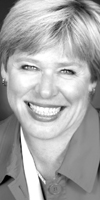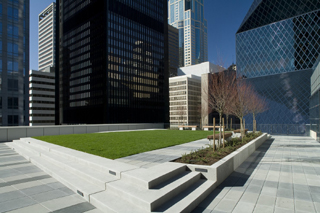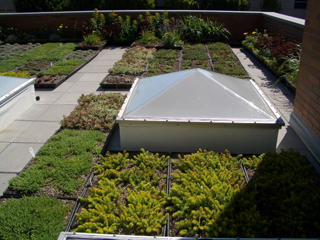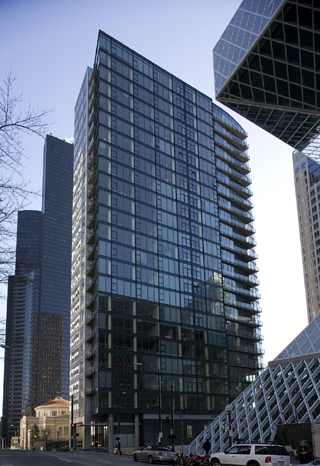
DJC.COM
May 29, 2008
Condo owners are seeing green
Williams Marketing

Williams
|
The green building trend began three decades ago with hard-core, back-to-the-earth environmentalists building smaller funky homes with unusual building materials (think straw bale) and willing to experiment with new technologies like solar panels.
It was a small movement that percolated quietly along until a few years ago, when green building began to get popular because of escalating energy and resource costs and, secondarily, a concern for the planet’s health.
Interestingly, when the movement really gained speed it was primarily on the commercial side. Now, however, residential building is starting to enter the green game in a big way.

Photo by Mike Seidl
A plaza next to the 5th and Madison tower offers green space during the day to condo residents and the public.
|
Seattle leads the nation with LEED buildings, including condominium and townhome projects along with single-family homes. But this time around, green homes have lost the funk and opted for a mainstream look. By doing that, they are attracting a whole new set of buyers, namely those whose first motivation is not to save the planet but to have a home with reduced energy bills, better indoor air quality, and more recycling of such things as rain water and construction materials.
Peter Sirota is one of the buyers who acknowledge that the green certification at the downtown condominium Olive 8 was not his deciding factor. He says the environmental elements indicate to him both creativity and high quality. Sirota, who was one of the early buyers at Olive 8, says his home has already increased in value, even though the building won’t open until December.
Not cookie cutters
Local developer R.C. Hedreen designed Olive 8 to be the first LEED-certified hotel/condominium in the Northwest. It will include a Hyatt Hotel on the lower 17 floors and condos on floors 18 through 39.
Southern California developer Kennedy Wilson last November opened its 5th and Madison high-rise condominium in downtown. The project is seeking gold LEED certification and offers interesting examples of the variety of ways that a building can go green.
There is no cookie-cutter approach to building green because the best green buildings are designed to be site-specific and there is a wide array of different green technologies to choose from.
Both 5th and Madison and Olive 8 share a focus on healthier indoor air, as that is a recognized consumer interest. With one in four Americans suffering from allergies and/or asthma, many people have come to understand that the new-home smell is not necessarily desirable. It typically means that the paints, solvents, glues and other finishes are made with volatile organic compounds (VOCs), which are noxious chemicals that can off-gas for years. Both of these buildings use low- or non-VOC paints, and 5th and Madison is also formaldehyde free.

Photo courtesy of greengridroofs.com
Developer R.C. Hedreen is building a green roof at the Olive 8 condo project, similar to this one, that it claims will be the largest in downtown Seattle. |
5th and Madison offers an excellent example of how to take advantage of existing site conditions to green up the homes. The property included underground parking, which turned out to be the perfect place to locate large cisterns that collect rainwater. Minus the underground parking, the cisterns would have been too expensive. But now 5th and Madison has all the non-city water it needs for landscaping and a water feature.
Homes at 5th and Madison take advantage of their generally north-facing orientation with floor-to-ceiling windows that are among the tallest downtown at 10.5 feet. If your home faces west and you have windows of that size, you have to close the shades much of the time to keep out the glare and heat.
The 5th and Madison site, a former bank branch drive-through and parking area, also offered a rare opportunity to carve out a half-acre park, which is owned by the office tower on the same block and open to the public during the day. That green space also acts as a water-conserving green roof over the existing retail.
Helping the environment

Photo by Mike Seidl
Kennedy Wilson is seeking gold LEED certification on its 5th and Madison condo tower in downtown Seattle. |
At Olive 8, Hedreen was the first to take advantage of King County’s relatively new transfer of development rights option. The developer paid almost $1 million for habitat preservation in exchange for the right to build a taller building. Some of that money has already been used to improve Sugarloaf Mountain Forest near Kent and the rest is held in the county’s development bank for future use to protect salmon habitat in rural King County.
Hedreen decided to build the largest green roof in downtown Seattle at Olive 8. It will provide habitat for bees, birds and butterflies. So, Hedreen wins green points for preserving habitat both in the rural parts of the county and in the middle of downtown.
Olive 8 will use significantly less water, thanks to a new technology that allows it to capture steam condensation from its heating system. That condensation will be cooled and then used for landscaping and for the swimming pool in the Hyatt at Olive 8 Hotel. Sustainable engineers at Rushing Co. helped develop the technology, which requires far less water in the cooling tower process.
The practical side to these green innovations should be lower utility bills, which should be reflected in lower homeowner fees.
The buyers who are already living at 5th and Madison and those who are waiting for their new homes at Olive 8 are typical of the new breed of green buyers. They are affluent, urban, sophisticated and interested in healthy living. They are looking first for a home that is beautiful and meets their needs, but are delighted to find that their cool new downtown digs are also green.
Two years ago, an article in Harvard Business Review asserted that green buildings cost no more to build when green was considered from the beginning. It went on to say that non-green buildings would soon be “dinosaurs” and harder to sell, rent or lease.
That article, coming from a respected and prestigious journal that did not have an environmental focus, took the design and construction world by storm. And as time has passed, studies from a wide range of sources are confirming that green building is the future whose time has already come in progressive cities such as Seattle.
With governmental and consumer support strong, the shift to green is accelerating all over the country and green has become shorthand for “high performance” and seen as a better investment and an important marketing differentiator, especially in a cooled real estate market.
Leslie Williams, a 25-year real estate veteran, is president and founder of Williams Marketing, a regional condominium marketing and sales firm. The firm has sold more than 11,000 condos since 1982. <
Other Stories:
- Is your building in it for the long run?
- Community-engaging design activates civic spaces
- How stewardship benefits Seattle’s streets
- Seattle needs more work to reach its urban potential
- Keeping infill projects predictable and on schedule
- Downtown condo pipeline favors sellers
- A new urban neighborhood to spring forth in Bellevue
- Tech campuses follow the San Jose model
- Sustainability starts with historic preservation
Copyright ©2009 Seattle Daily Journal and DJC.COM.
Comments? Questions? Contact us.